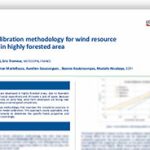← Return
Actual wake loss of large wind farms and its simulation: a Goldwind’s case study
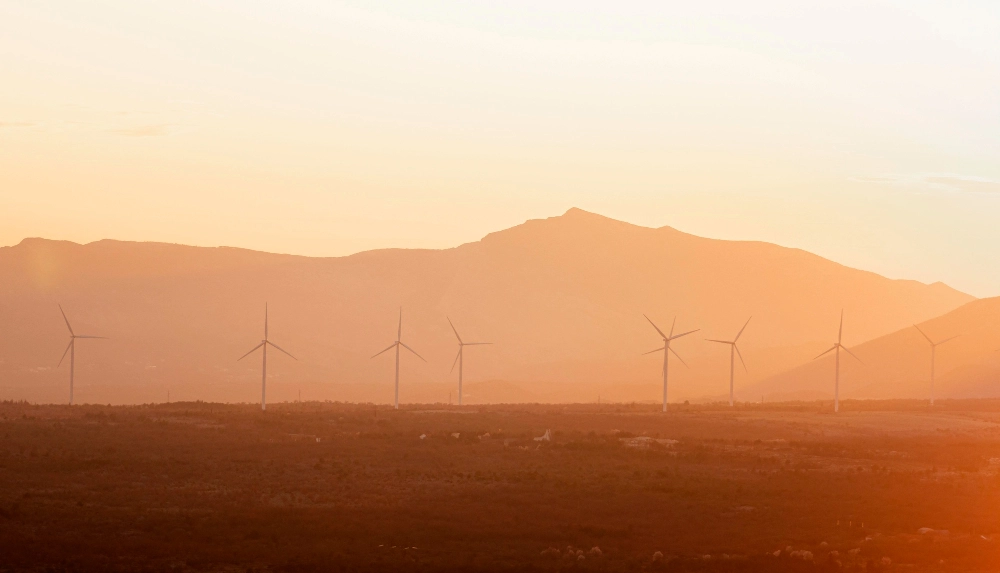
In this case study, Goldwind demonstrates the efficacy of wake modeling approaches in quantifying the wake losses experienced by large-scale wind farms.
A precise quantification of the actual wake losses afflicting a specific wind farm is executed, leveraging operational data.
For the simulation of the wake phenomenon, two distinct wake models incorporated within Meteodyn WT software have been utilized: a modified version of the PARK model and the Large Wind Farm model. A comparative analysis reveals that the Large Wind Farm model exhibits superior performance and is, thus, strongly advocated for in evaluating the wake impact on sizable wind farm arrays.
This inquiry into wake model efficiency originated from content disseminated by the WeChat account Yufengzhidao, managed by Beijing Goldwind Science & Creation Windpower Equipment Co., Ltd., a leader in the field.
Site description
The study site is situated within the expansive reaches of the Gobi Desert in Xinjiang Province, China. Characterized by its uniformly flat topography and an absence of vegetation, the locale is an ideal setting for wind energy exploitation. The wind installation encompasses a cluster of forty turbines, each possessing a capacity of 2.5 MW. These turbines feature a rotor diameter of 140 meters coupled with a hub height of 90 meters.
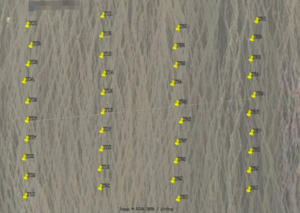 Spacing between adjacent turbines is judiciously calculated at 12.5 times the rotor diameter (D) aligned with the prevailing wind trajectory, and 3.2D along the axis that runs perpendicular to these dominant wind courses.
Spacing between adjacent turbines is judiciously calculated at 12.5 times the rotor diameter (D) aligned with the prevailing wind trajectory, and 3.2D along the axis that runs perpendicular to these dominant wind courses.
This intentional design ensures maximal wind capture and minimal wake interference, thus optimizing the power generation efficiency of the wind farm.
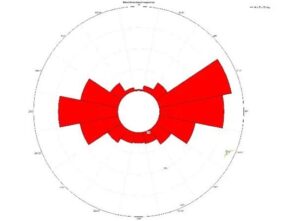 The picture on the left shows the wind rose from wind measurement campaign, offering a comprehensive overview of the prevailing wind patterns pertinent to the site of interest.
The picture on the left shows the wind rose from wind measurement campaign, offering a comprehensive overview of the prevailing wind patterns pertinent to the site of interest.Wake effect modeling
Within the Meteodyn WT framework, two wake models have been employed to investigate wake effects:
- The Modified PARK Model: This wake model is extensively recognized within the domain of wind resource assessment. It postulates an axisymmetric wake deficit extending downstream from the turbine. A noteworthy aspect of this model is the calculation of the wake decay constant ‘k,’ which is deduced from the turbulence intensity metrics. This approach provides a nuanced means of encapsulating the wake dynamic behavior influenced by atmospheric stability.
- The Large Wind Farm Model: This advanced model adeptly captures the complex interactions between a wind turbine cluster and the atmospheric boundary layer. It is predicated on conceptualizing the collective of turbines as an ‘equivalent roughness’, thereby modifying the characteristics of the flow within the boundary layer to reflect the aggregated impact of the wind farm’s presence.
A comparative analysis ensues, juxtaposing the projected wake losses from both models with actual wake loss factors, which are derived directly from the operational data accrued from the wind farm. This comparative approach extends across each of the identified dominant wind sectors, fostering a robust assessment of the models’ predictive precision relative to real-world wake behavior.
For easterly wind (79-101 deg):
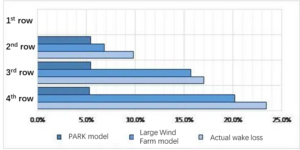
For westerly wind (259-281 deg):
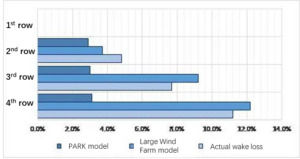
Conclusion and recommendation
Analysis of actual wake loss data reveals a discernible escalation in wake losses traversing from the second to the fourth rows of turbines, relative to the targeted wind direction.
The advanced simulation capabilities of the Large Wind Farm model are commendable, accurately reflecting the observed trend and quantifying wake loss factors with considerable fidelity. In contrast, the Modified PARK model exhibits limitations, notably failing to replicate the incremental wake loss pattern and consistently underestimating losses, particularly for the third and fourth turbine rows.
Considering these findings, it is substantiated that the Large Wind Farm model is the superior predictive tool for wake assessment tasks when addressing the complex dynamics of large-scale wind farms encompassing more than three consecutive rows of turbines. This model’s robust performance underscores its suitability for optimization of wind farm design and efficiency analysis in elaborate multi-turbine arrays.

